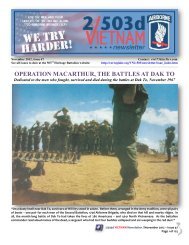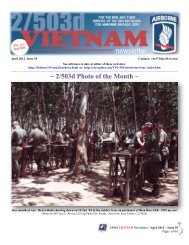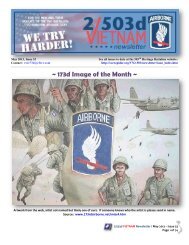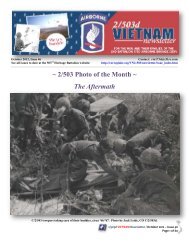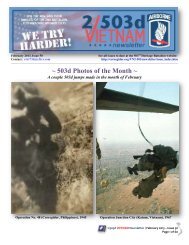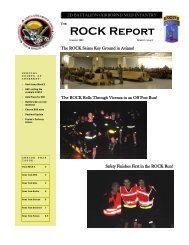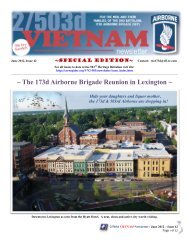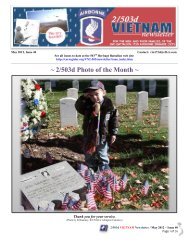173d Photo of the Month - Corregidor
173d Photo of the Month - Corregidor
173d Photo of the Month - Corregidor
You also want an ePaper? Increase the reach of your titles
YUMPU automatically turns print PDFs into web optimized ePapers that Google loves.
Airborne Soldier to Rock<br />
Legend<br />
A little bit <strong>of</strong> Airborne History<br />
Before he became <strong>the</strong> legend who<br />
was to become a rock icon, Jimi<br />
Hendrix was a paratrooper. James<br />
Hendrix got into trouble with <strong>the</strong><br />
law for riding in stolen cars. He<br />
was given a choice between<br />
spending two years in prison or<br />
joining <strong>the</strong> Army. Hendrix chose<br />
<strong>the</strong> latter and enlisted on May 31,<br />
1961.<br />
After completing basic training, in<br />
November 1962, Hendrix earned<br />
<strong>the</strong> right to wear <strong>the</strong> "Screaming<br />
Eagles" patch and was assigned to<br />
<strong>the</strong> 101st Airborne Division and stationed in Fort<br />
Campbell, Kentucky.<br />
His commanding <strong>of</strong>ficers and fellow soldiers considered<br />
him to be a sub-par soldier: he slept while on duty, had<br />
little regard for regulations, required constant<br />
supervision, and showed no skill as a marksman. For<br />
<strong>the</strong>se reasons, his commanding <strong>of</strong>ficers submitted a<br />
request that Hendrix be discharged from <strong>the</strong> military<br />
after he had served only one year. Hendrix did not<br />
object when <strong>the</strong> opportunity to leave arose. He would<br />
later tell reporters that he received a medical discharge<br />
after breaking his ankle during his 26th parachute jump.<br />
While in <strong>the</strong> Army, forged a friendship with a fellow<br />
soldier, Billy Cox, that would last until shortly before<br />
Hendrix's death. In his album, Axis: Bold as Love,<br />
Hendrix briefly spoke <strong>of</strong> his first parachuting<br />
experience: "...once you get out <strong>the</strong>re everything is so<br />
quiet, all you hear is <strong>the</strong> breezes-s-s-s..."<br />
Jimi Hendrix pioneered <strong>the</strong> explosive possibilities <strong>of</strong> <strong>the</strong><br />
electric guitar. Hendrix's innovative style <strong>of</strong> combining<br />
fuzz, feedback, and controlled distortion created a new<br />
musical form. Because he was unable to read or write<br />
music, it is nothing short <strong>of</strong> remarkable that Jimi Hendrix's<br />
meteoric rise in <strong>the</strong> music world took place in just<br />
four short years. His musical language continues to<br />
influence a host <strong>of</strong> modern musicians.<br />
One <strong>of</strong> Hendrix's most famous pieces is his psychedelic<br />
rendition <strong>of</strong> <strong>the</strong> U.S. national an<strong>the</strong>m, "The Star-<br />
Spangled Banner." Hendrix died on September 18th,<br />
1970, from drug-related complications.<br />
Jimi Hendrix, 27 Nov 1942 - 18 Sep 1970<br />
[Sent in by Ken Smith, A/2/503d, Sigholtz Chapter]<br />
Social Security<br />
Special Extra Earnings<br />
for Military Service<br />
Since 1957, if you had military service earnings for<br />
active duty (including active duty for training), you paid<br />
Social Security taxes on those earnings. Since 1988,<br />
inactive duty service in <strong>the</strong> Armed Forces reserves (such<br />
as weekend drills) has also been covered by Social<br />
Security.<br />
Under certain circumstances, special extra earnings for<br />
your military service from 1957 through 2001 can be<br />
credited to your record for Social Security purposes.<br />
These extra earnings credits may help you qualify for<br />
Social Security or increase <strong>the</strong> amount <strong>of</strong> your Social<br />
Security benefit.<br />
Special extra earnings credits are granted for periods <strong>of</strong><br />
active duty or active duty for training. Special extra<br />
earnings credits are not granted for inactive duty<br />
training.<br />
If your active military service occurred From 1957<br />
through 1967, we will add <strong>the</strong> extra credits to your<br />
record when you apply for Social Security benefits.<br />
From 1968 through 2001, you do not need to do<br />
anything to receive <strong>the</strong>se extra credits. The credits were<br />
automatically added to your record. After 2001, <strong>the</strong>re<br />
are no special extra earnings credits for military service.<br />
How You Get Credit For Special Extra Earnings<br />
The information that follows applies only to active duty<br />
military service earnings from 1957 through 2001.<br />
Here's how <strong>the</strong> special extra earnings are credited on<br />
your record:<br />
Service in 1957 Through 1977<br />
You are credited with $300. in additional earnings for<br />
each calendar quarter in which you received active duty<br />
basic pay.<br />
Service in 1978 through 2001<br />
For every $300. in active duty basic pay, you are<br />
credited with an additional $100. in earnings up to a<br />
maximum <strong>of</strong> $1,200. a year. If you enlisted after<br />
September 7, 1980, and didn't complete at least 24<br />
months <strong>of</strong> active duty or your full tour, you may not be<br />
able to receive <strong>the</strong> additional earnings. Check with<br />
Social Security for details.<br />
[Source: Social Security Administration]<br />
2/503d VIETNAM Newsletter / December 2011 – Issue 35<br />
Page 42 <strong>of</strong> 50



